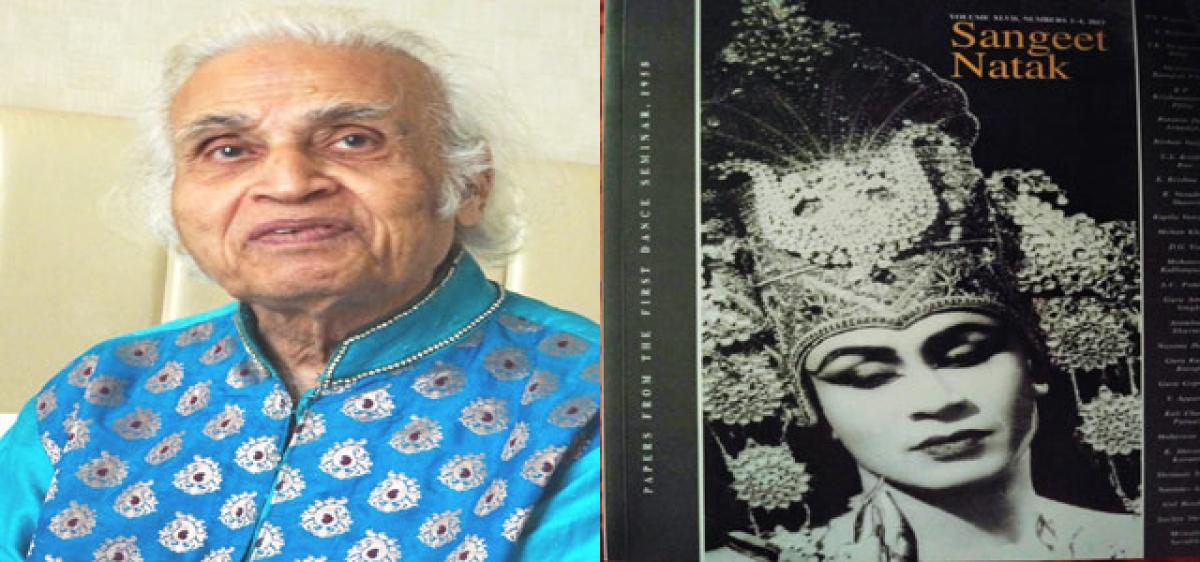Live
- AIIMS, CSIR to collaborate for research in healthcare, emerging technologies
- Midday meal scheme makes a comeback in junior colleges
- Why hands-on learning is the key to education
- Bhu Bharati unearths Dharani’s land scam
- Previous govt failed to tap Jal Jeevan Mission says Pawan Kalyan
- Govt replaces Dharani with Bhu Bharati
- Yogi govt merges 3 Ganga streams at Sangam
- BRS moves Privilege Motion against Cong over Musi Rejuvenation issue
- Food poisoning cases: Opposition, Treasury lock horns
- War of words between Ponnam, Gangula Kamalakar
Just In

Dr Sunil Kothari, Indian dance historian, scholar and senior critic was recently in Hyderabad to attend the Festival of Dance at Shilpakala Vedika organised by International Dance Research and Training Center (IDRTC) from Kuchipudi village.
It’s more important to bring the essence and aesthetics in a performance than to make it look more like an ‘IPL cricket match’
Dr Sunil Kothari, Indian dance historian, scholar and senior critic was recently in Hyderabad to attend the Festival of Dance at Shilpakala Vedika organised by International Dance Research and Training Center (IDRTC) from Kuchipudi village.
During an exclusive interview, he spoke about the process of tracing the two volumes of dance papers, which were originally submitted to the ‘All India Dance Seminar’ convened by Sangeet Natak Akademi in April, 1958 that went missing for some time, and the prominence of the historic seminar.
The dance critic who has had the opportunity to interact with many a dance legend in India is forthright about his views on the current state of affairs.
Can you tell us about the historic seminar ‘All India Dance Seminar and Dance Festival organised by Sangeet Natak Akademi in 1958?
Sangeet Natak Akademi since its formation in the year 1953 had been organising seminars on film, music and drama to take stock of the art and culture situation in the country in the post-independence period.
The seminar on dance was organised in 1958.Surprisingly, a few years back I found that the papers on dance presented at the 1958 conference were missing and not available in the records of Sangeet Natak Akademi.
I then started making efforts to trace the papers from many individuals like NC Jain and helped in the project undertaken by Geeta Chandran of Natya Vriksha. Finally two volumes of these papers are ready.
What is so important about that conference?
The Who’s Who of Indian dance was present at that conference. Eminent dance scholars and performers all over the country participated in the conference to express their views and it was a meeting point of some of the greatest minds of dance in India. And for me, it was well-known writer Mulk Raj Anand, who introduced me to Mohan Khokar.When I met him and spoke about my interest in dance, he told me about this seminar and asked me to be a part of it. Vignan Bhavan, New Delhi, was buzzing with activity.
And one could see performers and scholars like Lalitha, Padmini, Ragini (Travancore Sisters), Shambhu Maharaj, Rukmini Devi Arundale, Kamladevi Chattopadhyay, GVenkatachalam, PV Rajamannar (the first Chairman of Sangeet Natak Akademi ), Bala Saraswati and her mother Jayammal, Kumudini Lakhia, Amobi Singh, US Krishna Rao, Chandrabhaga Devi, Yamini Krishnamurty, Ellappa Pillai, Babulal Doshi, Kittappa Pillai, Mrinalini Sarabhai, Kapila Vatsayan, Gopinath, Kunchu Kurup, Atombapu Sharma, Kali Charan Patnaik, K. Shivaram Karanth, PNK. Bamzai, Santidev Ghose, MS Kallianpurkar, KP Krishnamoorthy Pillai, Sachin Shankar participating in the seminar.
After knowing such legends, how do you see the present state of classical dance in India?
It’s very unfortunate that ‘Choli ke Peeche Kya Hai’ and ‘Dhak Dhak Karne Laga’ are taking over the younger generation at large. There is a big splurge on the media about what is called ‘Bollywood dance’. The choice is only to switch off the channel. Nothing much can be done about this commercial consideration in giving such culture through media.
What about the young classical dancers?
There are some young dancers, who are committed to the roots of classical dance. Since most of the dance compositions are based in Sanskrit language, it is very important for all dancers to learn and understand the Sanskrit language. Without this they would not be able to bring in the ‘Rasa’ element in their performance.
How do you see the future of classical dance?
Classical dance has a purpose in life. Every performer must understand, experience this purpose of ‘inner well-being’ and transmit the same to the audience. Just giving a performance will not help. Opening an institution and training students and having their Arangetrams will not help. Not all students of dance get an opportunity of formal education.
There is a need to truly educate students not only in dance but also in general education (like in Kalakshetra). Many young dancers want to give ‘high speed’ performances. It’s more important to bring the essence and aesthetics in a performance than to make it look more like an ‘IPL cricket match’.

© 2024 Hyderabad Media House Limited/The Hans India. All rights reserved. Powered by hocalwire.com







